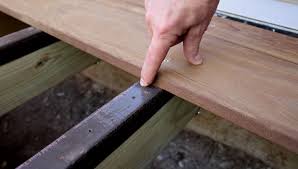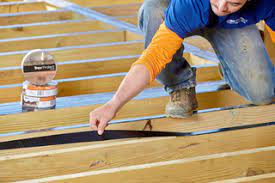Using joist tape on deck joists isn’t strictly required, but it’s highly recommended if you want your deck to last longer — especially if you’re using pressure-treated wood and Trex composite or PVC decking (which lasts longer than the framing underneath).
Using joist tape will increase the job’s cost. However, it does add more life to the pressure-treated frame of your deck. Joist tape is designed to keep water off a surface susceptible to rot. It can be used on beams, joists, and stringers.
Joist Tape is an odd product that hasn’t undergone sufficient long-term testing. The idea seems solid, and in theory, it should work. However, it is a work in progress.
The idea is much like shingles on a roof in that regard. Essentially, the butyl adheres to the material, and when you nail into that material, the butyl also adheres to the fastener.
One of the problems with untreated or stained decks is the water seeps into the hole created by the fastener and follows the fastener into the material and rots the joists from the inside. You can solve this issue with an overlay after the deck has been finished, but some people prefer the wooden look of a deck.


Regardless of joist Tape or not, decks do need replacing over time, and depending on the climate or rainfall averages depends on how often. Most butyl joist tape is the same
✅ Benefits of Joist Tape
-
Prevents rot and decay:
Joist tape seals the top of the joist, preventing water from soaking into screw holes or cracks in the wood. This slows down rot and extends the joist’s life. -
Protects against corrosion:
It creates a barrier between the wood and metal fasteners or hangers, reducing corrosion caused by chemicals in pressure-treated lumber. -
Improves long-term structural integrity:
Helps ensure the framing lasts as long as your decking boards — particularly important for composite or PVC decks that can last 25–50 years. -
Reduces squeaks:
Some tapes provide a small cushion between decking boards and joists, which can reduce movement noise over time.
⚠️ When It’s Especially Worth Using
-
When installing composite/PVC decking or Trex (since the decking will outlast untreated wood joists).
-
In wet or humid climates or where snow/ice linger.
-
On flat roofs or low-clearance decks where airflow is poor and drying is slow.
-
If you want to maximize return on investment—the cost is small compared to joist replacement later.
🚫 When It Might Be Overkill
-
For temporary or budget wood decks expected to last <10 years.
-
In very dry climates with minimal rain or snow.
🧰 Application Tips of Joist Tape
-
Use butyl-based tape (not asphalt), such as Trex Protect, Joist Tape, or Deck Protector — it sticks better and lasts longer in heat.
-
Apply to clean, dry joists before decking installation.
-
Overlap slightly on edges and press firmly to seal.
-
Cover tops of joists, beams, and ledger boards; you don’t need to wrap the entire joist.
Bottom line:
➡️ No, you don’t “need” joist tape — but yes, you absolutely should use it if you want to prevent rot and maximize deck lifespan.



